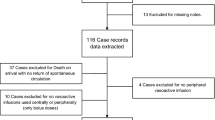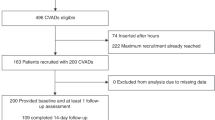Abstract
Objective:
To compare the patency duration of a peripheral intravenous cannula (PIVC) using either continuous infusion with 5% dextrose or intermittent flushing with 0.9% saline.
Study design:
Prospective comparative cohort study, including full-term newborn infants in whom PIVC were placed for the administration of antibiotics. In cohort 1 (n=48), 5% dextrose was infused at 3 ml h−1; in cohort 2 (n=50), the cannula was flushed six times daily with 2 ml 0.9% saline. Primary outcome was the duration of PIVC patency. Secondary outcomes included the occurrence of complications, time required by the nursing staff and the cost of materials.
Result:
Duration of PIVC patency was similar. However, significantly, more complications occurred in cohort 1 (P=0.02), and both cost and time were significantly lower in cohort 2 (P=0.001).
Conclusion:
Intermittent flushing and continuous infusion provide a similar duration of PIVC patency; however, intermittent flushing is associated with fewer complications, lower cost and reduced time.
This is a preview of subscription content, access via your institution
Access options
Subscribe to this journal
Receive 12 print issues and online access
$259.00 per year
only $21.58 per issue
Buy this article
- Purchase on Springer Link
- Instant access to full article PDF
Prices may be subject to local taxes which are calculated during checkout


Similar content being viewed by others
References
Flint A, Davies M . The intravenous cannula for newborn infants requiring only intravenous medication. J Infus Nurs 2008; 6: 346–349.
Kalyn A, Blatz S, Pinelli JA . Comparison of continuous infusion and intermittent flushing methods in peripheral intravenous catheters in neonates. J Intraven Nurs 2000; 23: 146–153.
Taylor J, Shannon R, Kilbride HW . Heparin lock intravenous line: use in newborn infants. Clin Pediatr 1989; 29: 237–240.
Perez A, Feuz I, Brotschi B, Bernet V . Intermittent flushing improves cannula patency compared to continuous infusion for peripherally inserted venous catheters in newborns: results from a prospective observational study. J Perinat Med 2012; 40: 311–314.
Flint A, McIntosh D, Davies MW . Continuous infusion versus intermittent flushing to prevent loss of function of peripheral intravenous catheters used for drug administration in newborn infants. Cochrane Database Syst Rev 2005; 19 (4): CD004593.
Pettit J . Assessment of the infant with a peripheral intravenous device. Adv Neonatal Care 2003; 3: 230–240.
Nieto-Rodriguez J, Garcia-Martin MA, Berrada Hernandez MD, Hervas MH, Cano-Real O . Heparin and infusion phlebitis: a prospective study. Ann Pharmacother 1992; 10: 1211–1214.
Maki D, Ringer M . Risk factors for infusion-related phlebitis with small peripheral venous catheters: a randomized controlled trial. Ann Intern Med 1991; 114: 845–854.
Shah PS, Ng E, Sinha AK . Heparine for prolonging peripheral intravenous catheter use in neonates. Cochrane Database Syst Rev 2005; 19: CD002774.
Upadhyay A, Verma KK, Lal P, Chawla D, Sreenivas V . Heparin for prolonging peripheral intravenous catheter use in neonates: a randomized controlled trial. J Perinatol 2015; 35: 274–277.
Arnts IJ, Heijnen JA, Wilbers HT, van der Wilt GJ, Groenewoud JM, Liem KD . Effectiveness of heparin solution versus normal saline in maintaining patency of intravenous locks in neonates: a double blind randomized controlled study. J Adv Nurs 2011; 67: 2677–2685.
de Lima Jacinto AK, Avelar AFM, Pedreira MLG . Predisposing factors for infiltration in children submitted to peripheral venous catheterization. J Infus Nur 2011; 34: 391–398.
Acknowledgements
We thank Dr D Grootendorst (clinical epidemiologist at the Landsteiner Institute, Medical Center Haaglanden) for providing helpful advice during our study.
Author information
Authors and Affiliations
Corresponding authors
Ethics declarations
Competing interests
The authors declare no conflict of interest.
Rights and permissions
About this article
Cite this article
Stok, D., Wieringa, J. Continuous infusion versus intermittent flushing: maintaining peripheral intravenous access in newborn infants. J Perinatol 36, 870–873 (2016). https://doi.org/10.1038/jp.2016.94
Received:
Revised:
Accepted:
Published:
Issue Date:
DOI: https://doi.org/10.1038/jp.2016.94



